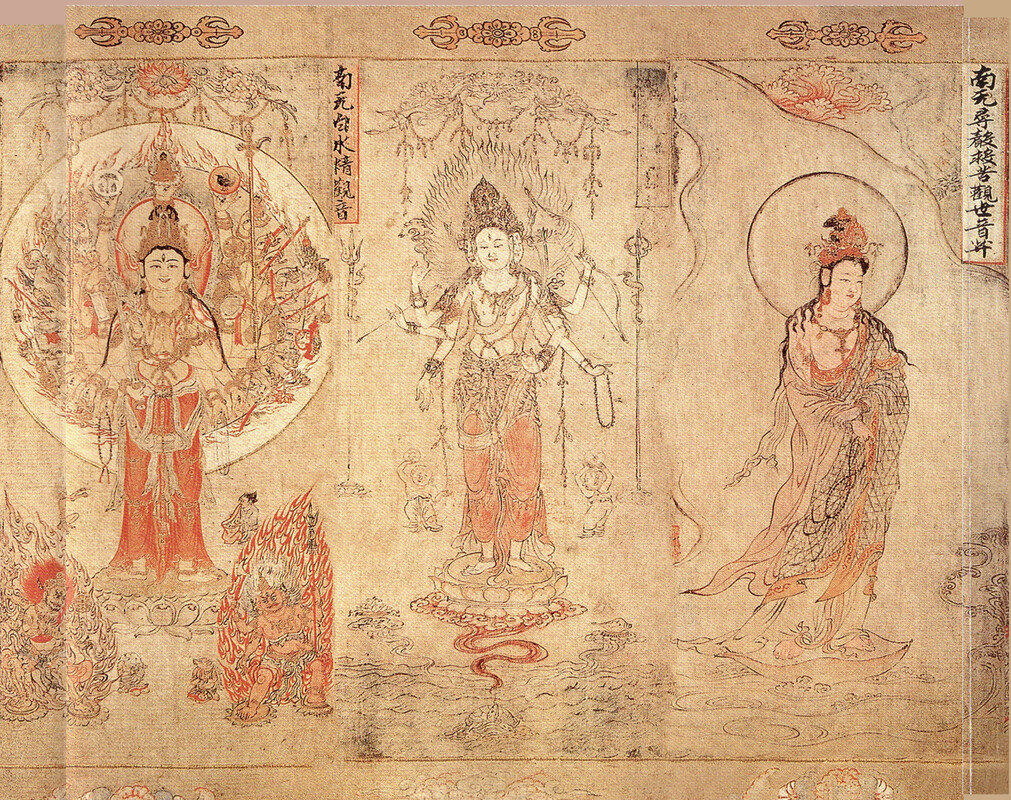The Thousand-armed Avalokiteśvara stands under a pink lotus canopy, from which hang garlands, Beside the usual forty arms with attributes there is a forty-first emerging from the top of Avalokiteśvara's head, which holds in the palm a seated figure of Amitābha Buddha. In the headdress of the Bodhisattva is another Amitābha, this time standing: a pose which violates the sādhana rules for dhyani Buddhas.
Avalokiteśvara has three haloes, the two inner ones flame-ringed. The outer one, which is, of course, the largest, does not extend below the knees, but reaches considerably above the head, the neck or shoulders of the divinity being about the center of the circle forming the halo. All three haloes are plain, without any suggestion of the thousand arms or hands, the eyes in the palms of which often form a kind of decoration of the haloes of this form of Avalokiteśvara. The divinity wears a red-pink skirt with a white scarf around the waist, which hangs down over the skirt; and he is adorned with jewelry—anklets, bracelets, jeweled collar, gold chains hanging over his skirt, etc. He stands on a white lotus, with magenta-tipped petals.
To the right is a small figure of a man with a black hat holding in his mouth and with both hands a red bag which is open, showing a pile of things inside. Opposite, a small man, naked except for a loincloth, holds out empty hands to Avalokiteśvara. To the right, nearer the foreground, is a fierce divinity, probably Vajrayaksa. He is three-headed and four-armed. His proper left upper hand holds a trident, his corresponding right hand holds a hatchet, and the other two make mudrā separately. Attending him, but facing from him towards the center, is Vajrāṅkuśā, a small swine-headed individual, kneeling. The fierce divinity opposite, probably Kuṇḍali Vidyārāja, has one head, with what appear to be snakes in his hair, and six arms, In his upper left hand, he holds a wheel; with his middle left, he makes a mudrā, and the third left is crossed in front with the third right hand. The upper right makes a mudrā; the middle holds a one-pointed vajra; and the third is crossed in front with the corresponding left hand. He is attended by Vināyaka (Gaṇeśa), a small Deva king with a white elephant's head, who kneels facing Vajrāṅkuśā, to whom he is pendent.
Each of the forty-one arms has an eye on the palm. The attributes held and the mudrās formed are as follows:
left outer hands
1. Sun disk with crow
2. Buddha
3. Long object
4. Sword
5. Utpala, blue lotus (?)
6. Hatchet
7. Stick from which hangs unidentified object
8. Shield
9. Tripartite cintāmani gem
10. Two lotuses
11. Conch
12. Willow spray (?)
13. Lasso.
left inner hands
14. Wheel
15. Ghaṇṭā bell
16. Round mirror
17. Lighted candle
18. Makes añjali mudrā with opposite hand
19. Long weapon
right outer hands
1. Moon disk with cassia tree and rabbit (or toad?)
2. Palace building
3. Flute
4. Monk's staff
5. Willow spray (?)
6. Single-pronged vajra
7. Stick, suspended skull
8. Bowl
9. Lotus
10. Ewer
11. Makes abhaya mudrā
12. Basket of fruit or candy
13. Rosary
right inner hands
14. Lotus
15. Five-pronged vajra
16. Rectangular mirror
17. Spray of leaves
18. Makes añjali mudrā with opposite hand
19. Long trident
20. Arrow |
Avalokiteśvara, with six arms and three heads, each with a third eye, is standing. In his crown is the dhyani Buddha Amitābha. He carries in his left hands the lotus, the bow, and the rosary. His upper right hand is in abhaya mudrā, and in the other two he carries an ascending cloud and an arrow. An antelope skin is thrown over his left shoulder. He wears anklets, bracelets on his upper and fore-arms, a long chain around his neck with pendants hanging over his arms, and a jeweled apron over his hips. He wears also a scarf. His long hair flows over his shoulders. He stands on a lotus which rests on a dark magenta cloud, which in turn issues from the mouth of a tortoise. The tortoise is swimming or floating on the surface of an expanse of water. To the right rises a small white cloud on which is a conch shell; to the left is a similar cloud bearing a dish of lotuses. Avalokiteśvara has a small, colorless halo with projections somewhat resembling the "fingers" of the fruit called Fo shou, Buddha's hand. Above is a white lotus canopy, garlanded. To both right and left of Avalokiteśvara is a trident standard, around which twines a snake. Two small boys stand, one on each side, each holding a disk; possibly representing the sun and moon.
南无白水精觀音。Adoration to Avalokiteśvara, the essence of plain water |
Avalokiteśvara, large in size, rides over waves on a lotus petal, tailing a blue cloud behind, to the right of which are magenta clouds. The funnel-shaped cloud is coming from above, rather than from behind, and so denotes a descent from on high and far away.
He is dressed in a yellow under-robe with a red-figured border at the top, which shows through his over-robe of net. This outer robe has a yellow border with tendril designs in red. A wide scarf of pale magenta hangs over his right arm, and another pale yellow scarf streams out. His right hand holds a rosary and his left hand rests on top of his right wrist. He wears a gold necklace, earrings, and an elaborate gold headdress in which is his dhyani Buddha, Amitābha.
南无尋聲救苦觀世音菩薩。Adoration to Avalokiteśvara who seeks the sound and saves from suffering |



